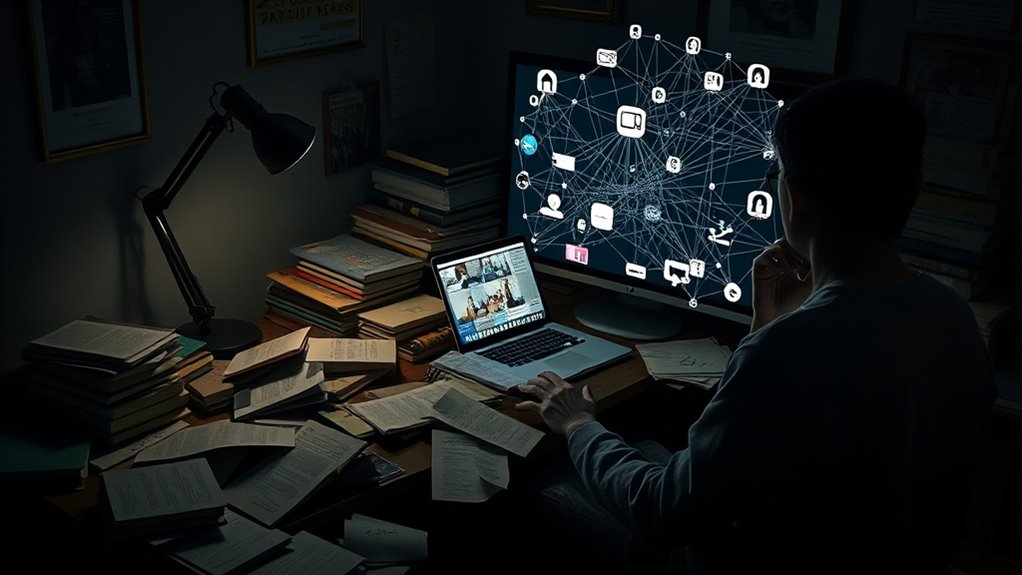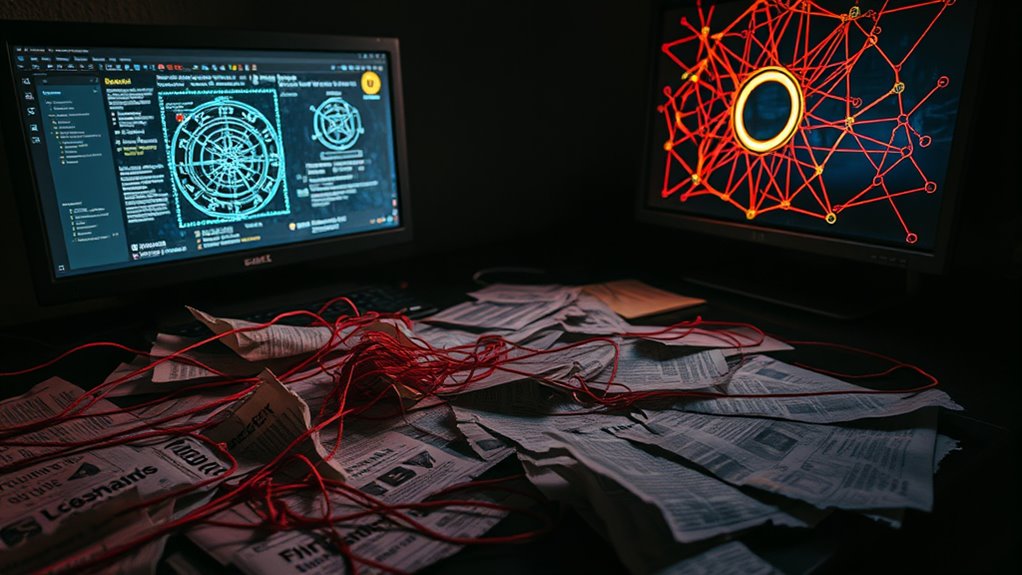Conspiracy theories spread because your mind is influenced by biases like confirmation bias, which makes you seek out information that supports your beliefs while dismissing evidence that contradicts them. Social media echo chambers expose you mainly to viewpoints that reinforce these ideas, creating an environment where false claims feel credible. Emotional needs for certainty and control, combined with social validation, further propel their spread. If you want to understand more, there’s much to uncover about these underlying factors.
Key Takeaways
- Confirmation bias and emotional needs reinforce beliefs and make conspiracy theories more convincing.
- Echo chambers and information silos limit exposure to opposing viewpoints, facilitating spread.
- People seek certainty and emotional comfort, favoring simple explanations over complex truths.
- Social influence and community validation boost acceptance and dissemination of conspiracy claims.
- Misinformation techniques, like using perceived credible cues, exploit trust and hinder critical evaluation.

Have you ever wondered why conspiracy theories spread so quickly and gain traction among different groups? The answer lies in how our minds are wired to process information, often influenced by psychological biases. These biases shape the way we interpret the world, making us more susceptible to accepting conspiracy theories without critical scrutiny. For example, confirmation bias leads you to favor information that supports your existing beliefs, while dismissing evidence that contradicts them. Once you’ve encountered a conspiracy theory that aligns with your worldview, you’re more likely to accept it as truth, reinforcing your beliefs rather than challenging them. This cycle makes it difficult to change your mind, especially when faced with complex or ambiguous information.
Confirmation bias reinforces beliefs, making it hard to challenge conspiracy theories and see them as false.
Another key factor is the role of information silos. These are environments—whether online communities, social media echo chambers, or even certain news outlets—where you mainly encounter viewpoints that reinforce your existing opinions. When you’re inside an information silo, you rarely get exposed to opposing perspectives. Instead, you encounter a curated stream of content that confirms your biases, making conspiracy theories appear more plausible. The more you engage within these silos, the more isolated you become from different viewpoints, and the easier it is for conspiracy theories to take root. They thrive in environments where critical thinking is limited, and where conflicting facts are dismissed or ignored.
Your tendency to seek comfort and certainty also fuels the spread of conspiracy theories. When faced with uncertainty or fear, your mind craves explanations that provide a sense of control or understanding, even if those explanations are false. Conspiracy theories often offer simple, emotionally satisfying narratives that blame a specific group or organization, making you feel like you’re uncovering hidden truths. This need for certainty can override your rational judgment, pushing you to accept and share these theories without sufficient evidence.
Furthermore, social influences amplify their spread. When you see others in your community or online circles sharing or endorsing conspiracy theories, you’re more likely to believe them yourself. Social proof acts as a powerful validator, especially when it comes from trusted peers. Combined with psychological biases and the insulation of information silos, these social dynamics create a fertile ground for conspiracy theories to flourish. Additionally, the use of sound vibrations and specific frequencies in related practices can sometimes be mistaken for evidence or misused to lend credibility to false claims, further complicating the spread of misinformation.
Understanding these underlying mechanisms helps you recognize how easily these theories can infiltrate your thinking. By being aware of psychological biases and actively seeking diverse perspectives beyond your information silos, you can better evaluate claims critically and prevent the unchecked spread of misinformation.
Frequently Asked Questions
How Do Conspiracy Theories Influence Public Trust in Institutions?
Conspiracy theories can erode your trust in institutions by fueling suspicion and doubt. When you encounter these theories, they challenge the credibility of authorities, causing trust erosion. As a result, you might question official information and become skeptical of institutional motives. This skepticism weakens your confidence in institutions, making it harder for them to maintain credibility and effectively serve the public, ultimately undermining societal stability.
What Psychological Traits Make Individuals More Susceptible to Conspiracies?
You’re more susceptible to conspiracies if you have certain personality traits and cognitive biases. Traits like paranoia, distrust, and a need for uniqueness make you seek out hidden truths. Cognitive biases like confirmation bias and pattern recognition cause you to favor information that supports your beliefs. These traits and biases work together, making you more likely to believe in conspiracy theories and less open to alternative explanations.
Can Conspiracy Theories Ever Be Proven True?
Yes, conspiracy theories can sometimes be proven true through evidence evaluation and truth verification. You need to critically examine credible sources and verify facts before accepting any claim. Keep in mind, many theories are based on speculation, but if solid evidence emerges and withstands scrutiny, they can be validated. Always question, investigate thoroughly, and rely on verified information to determine if a conspiracy theory holds truth.
How Do Social Media Algorithms Impact Conspiracy Theory Spread?
Social media algorithms substantially impact conspiracy theory spread by creating echo chambers where your exposure is limited to like-minded content. Algorithm bias favors sensational, controversial posts, making conspiracy theories more visible and engaging. You might find yourself repeatedly encountering similar ideas, reinforcing beliefs without question. This cycle amplifies misinformation and makes it harder to access diverse perspectives, ultimately strengthening the reach and influence of conspiracy theories online.
What Strategies Are Effective in Countering Conspiracy Beliefs?
Like a lighthouse guiding ships, media literacy and critical thinking are your best tools against conspiracy beliefs. You should question sources, verify facts, and seek credible information to challenge false claims. Engaging in respectful conversations and exposing misinformation with facts can also help. These strategies empower you to see through false narratives, making it harder for conspiracy theories to take hold and spread in your community.
Conclusion
Now, imagine digging into the facts behind a conspiracy theory, uncovering hidden details and questioning what you’ve been told. As you explore, you start to see how misinformation spreads like wildfire, fueled by fear and doubt. By seeking the truth, you can clear the fog of suspicion and visualize a clearer world. Remember, questioning is healthy—just make sure your curiosity leads you to facts, not fiction.






